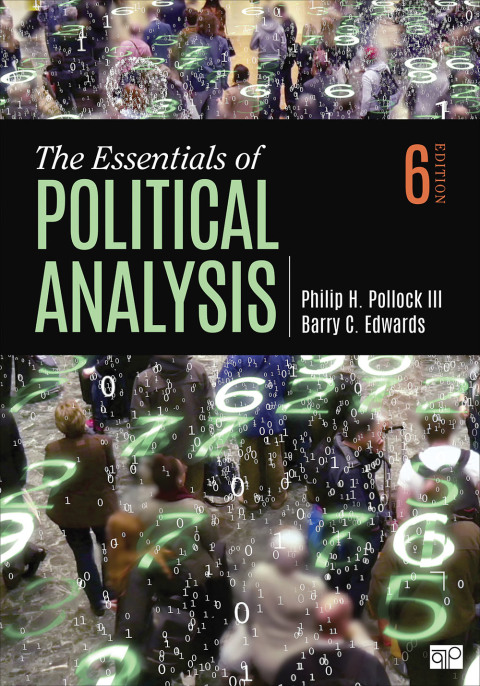Description
Efnisyfirlit
- Tables, Figures, and Boxes
- Preface
- Acknowledgments
- About the Authors
- Introduction
- Facts and Values in Perspective
- The Scientific Approach
- What This Book Is About
- Conclusion
- Key Terms
- Notes
- Chapter 1 • The Definition and Measurement of Concepts
- Learning Objectives
- Conceptual Definitions
- Clarifying a Concept
- A Template for Writing a Conceptual Definition
- Why It’s Important to Identify the Unit of Analysis
- Operational Definitions
- Measurement Error
- Systematic Measurement Error
- Random Measurement Error
- Reliability and Validity
- Evaluating Reliability
- Evaluating Validity
- Working with Datasets, Codebooks, and Software
- Summary
- Key Terms
- Exercises
- Notes
- Chapter 2 • Measuring and Describing Variables
- Learning Objectives
- Essential Features
- Levels of Measurement
- Nominal-level Variables
- Ordinal-level Variables
- Interval-level Variables
- Which Level of Measurement Is Best?
- Describing Variables
- Nominal Variables
- Ordinal Variables
- Interval Variables
- Transforming Variables
- Additive Indexes
- Sometimes Less Is More: Simplifying Variables
- Centering and Standardizing Interval-level Variables
- Advanced Data Transformation Methods
- Summary
- Key Terms
- Exercises
- Notes
- Chapter 3 • Proposing Explanations, Framing Hypotheses, and Making Comparisons
- Learning Objectives
- “All Models Are Wrong, But Some Are Useful”
- Proposing Explanations
- Causal Mechanisms
- Framing Hypotheses
- Common Mistakes in Hypothesis Writing
- Making Comparisons
- Cross-tabulations
- Mean Comparisons
- Graphing Relationships and Describing Patterns
- Summary
- Key Terms
- Exercises
- Notes
- Chapter 4 • Research Design, Research Ethics, and Evidence of Causation
- Learning Objectives
- Establishing Causation
- Experimental Designs
- Random Assignment
- Pretreatment Measurements
- Laboratory Experiments
- Field Experiments
- Selecting Cases for Analysis
- Random Sampling
- Weighting Sample Observations
- Nonrandom Sampling and Qualitative Research Designs
- Conducting Research Ethically
- Experiments Involving Human Subjects
- Ethical Responsibilities to the Academic Community
- Summary
- Key Terms
- Exercises
- Notes
- Chapter 5 • Making Controlled Comparisons
- Learning Objectives
- The Logic of Controlled Comparisons
- Essential Terms and Concepts
- Effect of Partisanship on Gun Control Vote, Controlling for Gender: An Illustrative Example
- A Spurious Relationship
- Additive Relationships
- Interactive Relationships
- Many Faces of Interaction
- Controlled Mean Comparisons
- Example of an Additive Relationship
- Example of an Interactive Relationship
- Identifying Patterns
- Advanced Methods of Making Controlled Comparisons
- Summary
- Key Terms
- Exercises
- Notes
- Chapter 6 • Foundations of Statistical Inference
- Learning Objectives
- Population Parameters and Sample Statistics
- The Central Limit Theorem and the Normal Distribution
- Quantifying Standard Errors
- Standard Error of a Sample Mean
- Standard Error of a Sample Proportion
- Confidence Intervals
- Sample Size and the Margin of Error of a Poll
- Inferences with Small Batches: The Student’s t-Distribution
- Summary
- Key Terms
- Exercises
- Notes
- Chapter 7 • Tests of Significance and Measures of Association
- Learning Objectives
- Statistical Significance and Null Hypothesis Testing
- One-Sample Significance Tests
- Two-Sample Significance Tests
- Difference of Means Test
- Difference of Proportions Test
- The Chi-square Test
- Measures of Association
- Lambda
- Somers’ dyx
- Cramer’s V
- Criticisms of Null Hypothesis Testing
- Summary
- Key Terms
- Exercises
- Notes
- Chapter 8 • Correlation and Linear Regression
- Learning Objectives
- Correlation
- Bivariate Regression
- Educational Attainment and Voter Turnout in States Example
- R-square
- Adjusted R-square
- Multiple Regression
- Regression with Multiple Dummy Variables
- Interaction Effects in Multiple Regression
- Some Practical Issues: Multicollinearity, Parsimony, and Missing Data
- Analyzing Residuals to Evaluate Linear Regression Models
- Summary
- Key Terms
- Exercises
- Notes
- Chapter 9 • Logistic Regression
- Learning Objectives
- The Logistic Regression Approach
- Logistic Regression Approach to Vote Choice in the 2016 Presidential Election
- Finding the Best Fit: Maximum Likelihood Estimation
- Logistic Regression with Multiple Independent Variables
- Graphing Predicted Probabilities with Multiple Independent Variables
- Marginal Effects at the Means
- Marginal Effects at Representative Values
- Summary
- Key Terms
- Exercises
- Notes
- Chapter 10 • Conducting Your Own Political Analysis
- Picking a Good Topic
- Getting Focused and Staying Motivated
- Reviewing Prior Literature
- Collecting Data
- Political Science Data Archives
- Making Observations
- Automated Data Collection
- Survey Research
- Interviews
- Writing It Up
- General Suggestions about Tone and Citations
- Suggestions for Clear Organization
- Maintain a Scientific Mindset
- Key Terms
- Exercises
- Notes
- Index






Reviews
There are no reviews yet.